From Systems to Complex Systems
I have studied complex systems science from following teachers:
- Yaneer Bar Yam of NECSI: Physical, Biological, and Social Systems
- Scott Page of University of Michigan: Model Thinking: Complex Systems in Economics and Social/Political Sciences.
- Melanie Mitchell of Santa Fe Institute: Introduction to Complex Systems
- Michael Kearns of University of Pennsylvania: Networked Life: Science of Networks
- Ravi Iyenger of Mount Sinai Icahn School of Medicine: Introduction to Systems Biology
- Perry Mehrling of Columbia University/INET: Economics of Money and Banking
- John Sterman of MIT: Business Dynamics: Using Systems Dynamics
Key Terms
- Complex Systems
- Networks
- Interaction
- Agents
- Bottom Up Modeling
- Agent Based Modeling
- Netlogo
- New England Complex Systems Institute (NECSI)
- Santa Fe Institute (SFI)
- Yaneer Bar Yam
- Scott Page
- Melanie Mitchell
- Network Science
- Dynamical Systems
- Cellular Automata
- Artifical Life (A-Life)
- Anti Fragility
- Agility
- Learning
- Adaptability
- Resilience
- Synchronization
- Mark Newman
- Albert Laszlo Barabasi
- John Sterman
- Small World Networks
- Scale Free Networks
- Hierarchy
- Boundaries
- Stephen Wolfram
- Stuart Kaufman
- Increasing Retuns
- Path Dependence
- J Doyne Farmer
- W. Brian Arthur
- Duncan Watts
- Eugene Stanley
- Six Degrees of Separation
- Emergence
- Non Linear Dynamics
- Competition and Cooperation
What are Complex Systems?
Source: A Brief History of Systems Science, Chaos and Complexity

Key Topics in Complex Systems
Sources: Complex Systems: A Survey
- Lattices and Networks
- Dynamical Systems
- Discrete Systems and Cellular Automata
- Scaling and Criticality
- Adaptation and Game Theory
- Information Theory
- Computational Complexity
- Agent based Modeling
- Chaos and Fractals
- Spontaneous Order and Synchronization
Complex Systems
The original journal devoted to the science, mathematics and engineering of systems with simple components but complex overall behavior; publishes high-quality articles that focus on, but are not limited to, the following areas:
- Dynamic, topological and algebraic aspects of cellular automata and discrete dynamical systems
- Complex systems and complexity theory
- Algorithmic complexity and information theory
- Emergent properties of dynamical systems
- Formal languages, grammars and automata
- Algorithmic information dynamics
- Symbolic dynamics and connections to continuous systems
- Tilings, rewriting and substitution systems
- Computability theory
- Synchronous versus asynchronous models
- Applications of automata to areas such as machine and deep learning, physics, biology, social sciences and others
Source: A Brief History of Systems Science, Chaos and Complexity
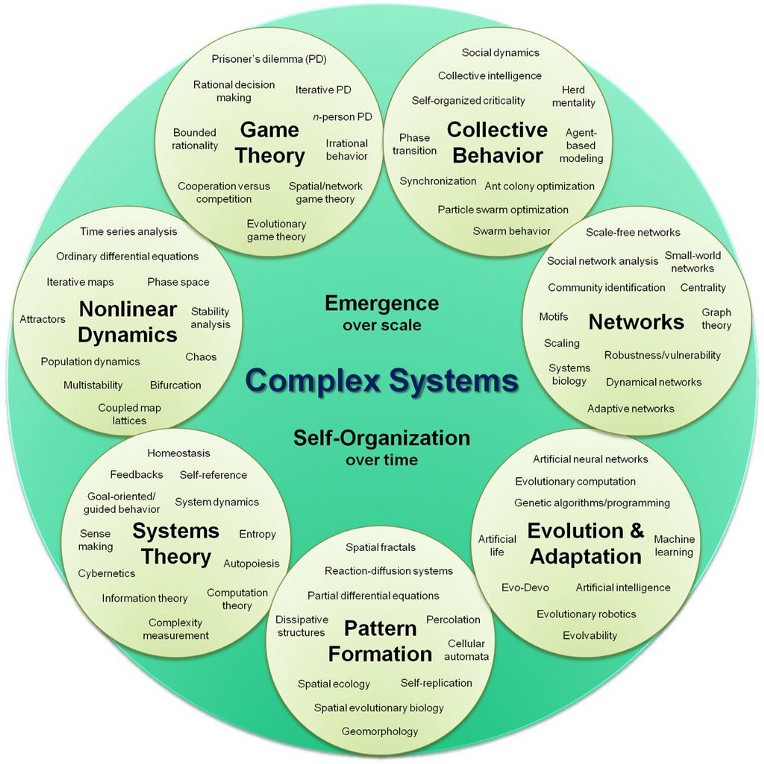
History of Systems and Complex Systems
Source: A Brief History of Systems Science, Chaos and Complexity
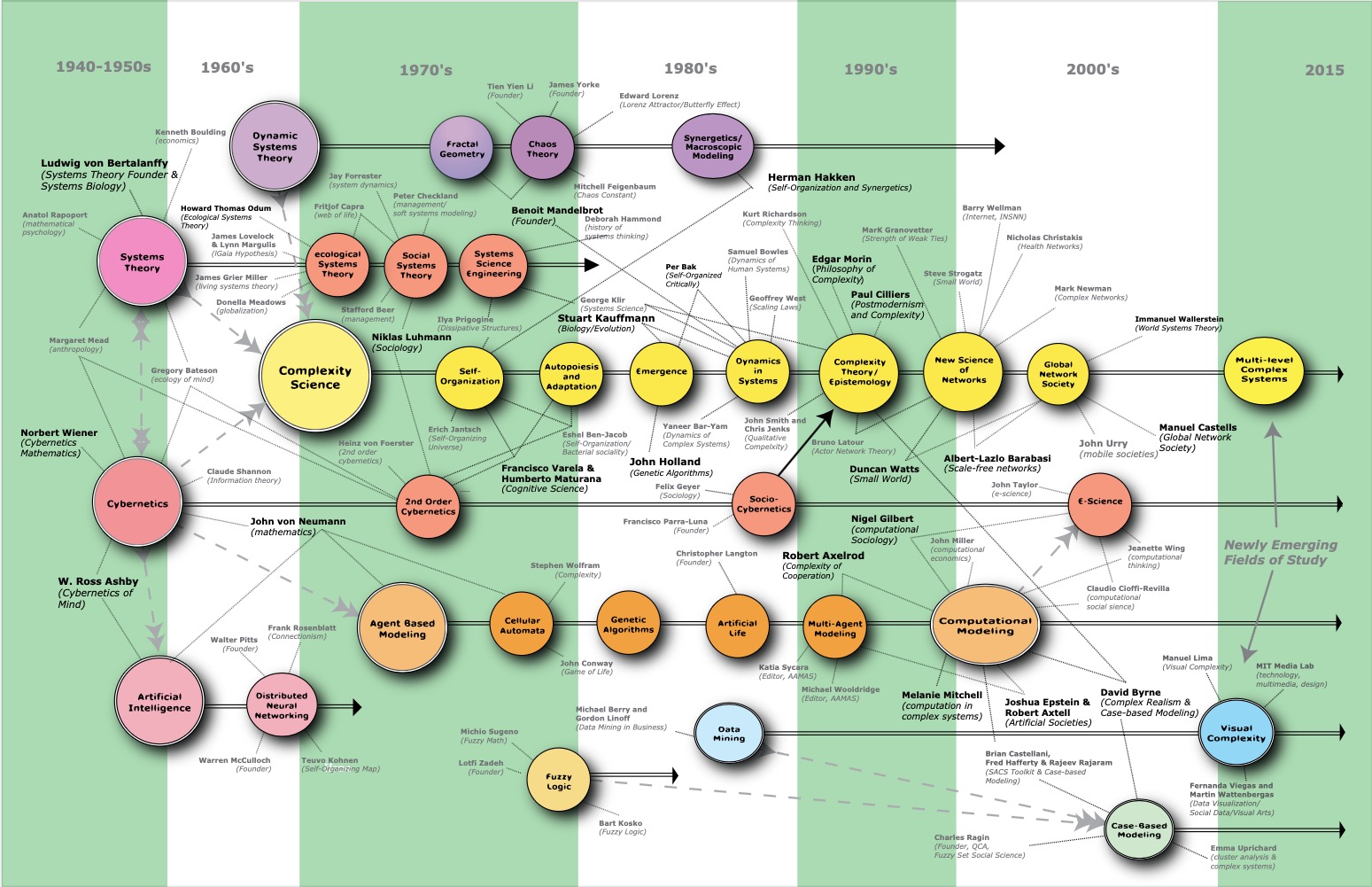
My Related Posts
Micro Motives, Macro Behavior: Agent Based Modeling in Economics
Systems Biology: Biological Networks, Network Motifs, Switches and Oscillators
System Archetypes: Stories that Repeat
Contagion in Financial (Balance sheets) Networks
Increasing Returns, Path Dependence, Circular and Cumulative Causation in Economics
Increasing Returns and Path Dependence in Economics
Interdependence in Payment and Settlement Systems
Classical roots of Interdependence in Economics
Feedback Thought in Economics and Finance
Jay W. Forrester and System Dynamics
Balance Sheets, Financial Interconnectedness, and Financial Stability – G20 Data Gaps Initiative
Oscillations and Amplifications in Demand-Supply Network Chains
Credit Chains and Production Networks
Wassily Leontief and Input Output Analysis in Economics
Key Sources of Research
An Introduction to Complex Systems Science and Its Applications
Alexander F. Siegenfeld 1,2 and Yaneer Bar-Yam2
1Department of Physics, Massachusetts Institute of Technology, Cambridge, MA, USA 2New England Complex Systems Institute, Cambridge, MA, USA
Hindawi
Complexity
Volume 2020, Article ID 6105872, 16 pages https://doi.org/10.1155/2020/6105872
https://necsi.edu/an-introduction-to-complex-systems-science-and-its-applications
https://www.hindawi.com/journals/complexity/2020/6105872/
COMPLEXITY RISING:
From Human Beings to Human Civilization, a Complexity Profile
NECSI
https://necsi.edu/complexity-rising-from-human-beings-to-human-civilization-a-complexity-profile
MULTISCALE COMPLEXITY/ENTROPY
Advances in Complex Systems Vol. 07, No. 01, pp. 47-63 (2004)
https://doi.org/10.1142/S0219525904000068
GENERAL FEATURES OF COMPLEX SYSTEMS
Y. Bar-Yam
New England Complex Systems Institute, Cambridge, MA, USA
The why, how, and when of representations for complex systems
Leo Torres
leo@leotrs.com
Network Science Institute, Northeastern University
Danielle S. Bassett
dsb@seas.upenn.edu
Department of Bioengineering, University of Pennsylvania
Ann S. Blevins
annsize@seas.upenn.edu
Department of Bioengineering, University of Pennsylvania
Tina Eliassi-Rad
tina@eliassi.org
Network Science Institute and Khoury College of Computer Sciences, Northeastern University
June 5, 2020
Santa Fe Institute
Strategy and Complex Systems
wayne.smith@csun.edu
Thursday, December 10, 2020
Learning to Live with Complexity
by
HBR (September 2011)
MULTIDISCIPLINARY COMPLEX SYSTEMS RESEARCH
Report from an NSF Workshop in May 2017
Kimberly A. Gray, Northwestern University, Co-Chair
Adilson E. Motter, Northwestern University, Co-Chair
Center for Study of Complex System
University of Michigan
Complex Systems Theory
1988 Stefan Wolfram
What is a complex system?
- June 2013
- European Journal for Philosophy of Science 3(1)
- Project: Complexity Science
Authors:
https://www.researchgate.net/publication/50210075_What_is_a_complex_system
Learning in and about complex systems
MIT System Dynamics
First published: Summer ‐ Autumn (Fall) 1994 https://doi.org/10.1002/sdr.4260100214
Complex Systems
Science for the 21st Century
A U.S. Department of Energy, Office of Science Workshop
Effectiveness of Leadership Decision-Making in Complex Systems
by Leonie Hallo 1,*, Tiep Nguyen 2, Alex Gorod 1 and Phu Tran 2
1Adelaide Business School, University of Adelaide, Adelaide, South Australia 5000, Australia
2Transport Economic Faculty, Ho Chi Minh University of Transport, Ho Chi Minh 700000, Vietnam
*Author to whom correspondence should be addressed.
Systems2020, 8(1), 5; https://doi.org/10.3390/systems8010005
Received: 4 January 2020 / Revised: 2 February 2020 / Accepted: 7 February 2020 / Published: 12 February 2020
https://www.mdpi.com/2079-8954/8/1/5
Debate the Issues: Complexity and policy makIng
OECD
OECD Insights, OECD Publishing, Paris, http://dx.doi.org/10.1787/9789264271531-en.
The Rising Complexity of the Global Economy
OECD Insights
http://oecdinsights.org/2016/09/02/the-rising-complexity-of-the-global-economy/
Introduction to the Theory of Complex Systems
Stefan Thurner, Rudolf Hanel, and Peter Klimek
Medical University of Vienna, Austria
Modeling Complex Systems
Nino Boccara
Springer
Taming Complexity
Make sure the benefits of any addition to an organization’s systems outweigh its costs. by
HBR Magazine (January–February 2020)
https://hbr.org/2020/01/taming-complexity
How do I manage the complexity in my organization?
Suzanne Heywood
Rubén Hillar
David Turnbull
McKinsey 2010
Agility: The antidote to complexity
Deloitte 2021 Global Chief Procurement Officer Survey
Unlocking The True Value Of Digital Transformation
Modernize your IT Services to tackle rising complexity
A Forrester Consulting
Thought Leadership Paper Commissioned By Tata Consultancy Services
June 2020
WHAT MAKES A SYSTEM COMPLEX?
AN APPROACH TO SELF ORGANIZATION AND EMERGENCE
Michel Cotsaftis
LACSC/ECE mcot@ece.fr
An introduction to complex system science ∗
Lecture notes for the use of master students in Computer Science and Engineering
Andrea Roli andrea.roli@unibo.it
DISI – Dept. of Computer Science and Engineering Campus of Cesena
Alma Mater Studiorum Universita` di Bologna
What is a Complex System?
James Ladyman, James Lambert
Department of Philosophy, University of Bristol, U.K.
Karoline Wiesner
Department of Mathematics and Centre for Complexity Sciences, University of Bristol, U.K.
(Dated: March 8, 2012)
Overview of Complex Systems
Principles of Complex Systems | @pocsvox CSYS/MATH 300, Fall, 2013 | #FallPoCS2013
Prof. Peter Dodds| @peterdodds
Introduction to the Theory of Complex Systems
- R. Hanel, S. Thurner, P. Klimek
- Published 2018
Click to access book-thurner18.pdf
Foundations of Complex-system Theories: In Economics, Evolutionary Biology …
By Sunny Y. Auyang
From simplistic to complex systems in economics
John Foster*
Cambridge Journal of Economics 2005, 29, 873–892
doi:10.1093/cje/bei083
Complex Systems: A Survey
M. E. J. Newman
Department of Physics, University of Michigan, Ann Arbor, MI 48109 and
Center for the Study of Complex Systems, University of Michigan, Ann Arbor, MI 48109
Designing to learn about Complex Systems
Click to access hmelo_00_designing_to_learn_complex.pdf
Complex systems: Network thinking
Melanie Mitchell
Artificial Intelligence 170 (2006) 1194–1212
Statecharts: a visual formalism for complex systems
Science of Computer Programming
Volume 8, Issue 3, June 1987, Pages 231-274
https://www.sciencedirect.com/science/article/pii/0167642387900359
Control Principles of Complex Networks
Yang-YuLiu1,2 andAlbert-L ́aszl ́oBarab ́asi3,2,4,5 1Channing Division of Network Medicine,
Brigham and Women’s Hospital,
Harvard Medical School,
Boston, Massachusetts 02115,
USA
2Center for Cancer Systems Biology, Dana-Farber Cancer Institute, Boston, Massachusetts 02115,
USA
3Center for Complex Network Research and Departments of Physics, Computer Science and Biology,
Northeastern University,
Boston, Massachusetts 02115,
USA
4Department of Medicine,
Brigham and Women’s Hospital,
Harvard Medical School,
Boston, Massachusetts 02115,
USA
5Center for Network Science,
Central European University, Budapest 1052,
Hungary
(Dated: March 15, 2016)
Physical approach to complex systems
Jarosław Kwapień a,∗, Stanisław Drożdż a,b
a Complex Systems Theory Department, Institute of Nuclear Physics, Polish Academy of Sciences, PL–31-342 Kraków, Poland
b Institute of Computer Science, Faculty of Physics, Mathematics and Computer Science, Cracow University of Technology, PL–31-155 Kraków, Poland
Physics Reports 2011
Dynamics of Complex Systems (Studies in Nonlinearity)
Yaneer Bar-Yam,
Addison-Wesley, New York, 1997; ISBN 0-201-55748-7; 800 pp.,
https://necsi.edu/dynamics-of-complex-systems
MODULARITY AND INNOVATION IN COMPLEX SYSTEMS
SENDIL K. ETHIRAJ
The Wharton School of Business
3620 Locust Walk, Suite 2000 University of Pennsylvania, Philadelphia PA 19104 Ph. 215-898 1231
Email: sethiraj@wharton.upenn.edu
DANIEL LEVINTHAL University of Pennsylvania
https://journals.aom.org/doi/pdf/10.5465/apbpp.2002.7519521
Complex Systems—A New Paradigm for the Integrative Study of Management, Physical, and Technological Systems
Luis A. Nunes Amaral
Department of Chemical and Biological Engineering, McCormick School of Engineering, Northwestern University, Evanston, Illinois 60208, amaral@northwestern.edu
Brian Uzzi
Department of Management and Organizations, Kellogg School of Management, Northwestern University, Evanston, Illinois 60208, uzzi@northwestern.edu
MANAGEMENT SCIENCE
Vol. 53, No. 7, July 2007, pp. 1033–1035
issn 0025-1909 eissn 1526-5501 07 5307 1033
http://citeseerx.ist.psu.edu/viewdoc/download?doi=10.1.1.728.1068&rep=rep1&type=pdf
Boundaries, Hierarchies and Networks in Complex Systems
PAUL CILLIERS
Department of Philosophy University of Stellenbosch Stellenbosch7600 South Africa
Fpc@akad.sun.ac.za
International Journal of Innovation Management, Vol. 5, No. 2 (June 2001) pp. 135–147
Click to access Cilliers-2001-Boundaries-Hierarchies-and-Networks.pdf
Extracting the hierarchical organization of complex systems
Marta Sales-Pardo, Roger Guimera` , Andre ́ A. Moreira, and Luís A. Nunes Amaral*
Department of Chemical and Biological Engineering and Northwestern Institute on Complex Systems, Northwestern University, Evanston, IL 60208
Edited by H. Eugene Stanley, Boston University, Boston, MA, and approved July 22, 2007 (received for review April 23, 2007)
PNAS November 20, 2007 vol. 104 no. 47
Patterned Interactions in Complex Systems: Implications for Exploration.
Rivkin, J. W., & Siggelkow, N. (2007).
Management Science, 53 (7), 1068-1085. http://dx.doi.org/10.1287/mnsc.1060.0626
A complex systems approach to constructing better models for managing financial markets and the economy
J. Doyne Farmer1, M. Gallegati2, C. Hommes3, A. Kirman4, P. Ormerod5, S. Cincotti6, A. Sanchez7, and D. Helbing8
1 Santa Fe Institute, 1399 Hyde Park Road, Santa Fe, NM 87501, USA
2 DiSES, Universit Politecnica delle Marche, Ancona, Italy
3 CeNDEF, University of Amsterdam, The Netherlands
4 GREQAM, Aix Marseille Universit ́e, EHESS, France
5 Volterra Partners, London and University of Durham, UK
6 DIME-DOGE.I, University of Genoa, Italy
7 GISC, Universidad Carlos III de Madrid, Spain
8 ETH, Zu ̈rich
Received 1 August 2012 / Received in final form 9 October 2012 Published online 5 December 2012
Eur. Phys. J. Special Topics 214, 295–324 (2012)
THE ONTOLOGY OF COMPLEX SYSTEMS: Levels of Organization, Perspectives, and Causal Thickets*
(Canadian Journal of Philosophy, supp. vol #20, 1994, ed. Mohan Matthen and Robert Ware, University of Calgary Press, 207-274).
by William C. Wimsatt
Department of Philosophy
University of Chicago
January 4, 1994
wwim@midway.uchicago.edu
http://citeseerx.ist.psu.edu/viewdoc/download?doi=10.1.1.177.6704&rep=rep1&type=pdf
Requisite variety and its implications for the control of complex systems,
Ashby W.R. (1958)
Cybernetica 1:2, p. 83-99.
http://pcp.vub.ac.be/Books/AshbyReqVar.pdf,
Click to access ashbyreqvar.pdf
Weak Links
The Universal Key to the Stability of Networks and Complex Systems
P ́eter Csermely
February 25, 2009
Weak Links: Stabilizers of Complex Systems from Proteins to Social Networks,
by Peter Csermely.
2006 XX, 408 p. 37 illus. 3-540-31151-3. Berlin: Springer, 2006.
An Introduction to Agent-Based Modeling: Modeling Natural, Social, and Engineered Complex Systems with NETLogo
Wilensky, Uri and Rand, William MIT Press: London, 2015
ISBN 978-0262731898 (pb)
Dynamics of Complex Systems: Scaling Laws for the Period of Boolean Networks
Réka Albert and Albert-László Barabási*
Department of Physics, University of Notre Dame, Notre Dame, Indiana 46556
(Received 28 April 1999)
PHYSICAL REVIEW LETTERS
VOLUME 84, NUMBER 24
12 JUNE 2000
Cities as Complex Systems: Scaling, Interactions, Networks, Dynamics
and Urban Morphologies
ISSN 1467-1298
Michael Batty
Centre for Advanced Spatial Analysis, University College London, 1-19 Torrington Place, London WC1E 6BT, UK
Email: m.batty@ucl.ac.uk, Web: www.casa.ucl.ac.uk
The Encyclopedia of Complexity & System Science, Springer, Berlin, DE, forthcoming 2008. Date of this paper: February 25, 2008.
Scale invariance and universality: organizing principles in complex systems
H.E. Stanleya;∗, L.A.N. Amarala , P. Gopikrishnana , P.Ch. Ivanova , T.H. Keittb , V. Pleroua
aCenter for Polymer Studies and Department of Physics, Boston University, Boston, MA 02215, USA bNational Center for Ecological Analysis and Synthesis, 735 State Street, Suite 300,
Santa Barbara, CA 93101, USA
Physica A 281 (2000) 60–68
A pragmatist approach to transdisciplinarity in sustainability research: From complex systems theory to reflexive science
Florin Popa
Mathieu Guillermin
Tom Dedeurwaerdere
Futures
Volume 65, January 2015, Pages 45-56
http://dx.doi.org/10.1016/j.futures.2014.02.002
https://www.sciencedirect.com/science/article/pii/S0016328714000391
Extracting and Representing Qualitative Behaviors of Complex Systems in Phase Spaces
Feng Zhao
MASSACHUSETTS INSTITUTE OF TECHNOLOGY
ARTIFICIAL INTELLIGENCE LABORATORY
A.I. Memo No. 1274 Marc]: 1991
What is a Complex System?
James Ladyman, James Lambert
Department of Philosophy, University of Bristol, U.K.
Karoline Wiesner
Department of Mathematics and Centre for Complexity Sciences, University of Bristol, U.K.
(Dated: March 8, 2012)
Click to access LLWultimate.pdf
Modelling and prediction in a complex world
Michael Battya, Paul M. Torrensb,*
aCentre for Advanced Spatial Analysis, University College London, 1 to 19 Torrington Place, London WC1E 6BT, UK
bDepartment of Geography, University of Utah, 260 S. Central Campus Dr., Rm. 270, Salt Lake City, UT 84112-9155, USA
Available online 19 March 2005
Click to access 2005-futures-complexity.pdf
Complex networks
Augmenting the framework for the study of complex systems
THE EUROPEAN PHYSICAL JOURNAL B
L.A.N. Amarala and J.M. Ottino
Department of Chemical and Biological Engineering, Northwestern University, Evanston, IL 60208, USA
Received 12 November 2003
Published online 14 May 2004
Eur. Phys. J. B 38, 147–162 (2004) DOI: 10.1140/epjb/e2004-00110-5
Learning from Evidence in a Complex World
John D. Sterman
Jay W. Forrester Professor of Management and Professor of Engineering Systems Sloan School of Management
Massachusetts Institute of Technology
30 Wadsworth Street, E53-351
Cambridge MA 02142
617.253.1951
jsterman@mit.edu
web.mit.edu/jsterman/www
Revision of May 2005
Forthcoming,
American Journal of Public Health
Click to access LearningFromEvidenceFinal.pdf
INTERDISCIPLINARY DESCRIPTION OF COMPLEX SYSTEMS
7(2), pp. 22-116, 2009 ISSN 1334-4684
Error and attack tolerance of complex networks
R ́eka Albert, Hawoong Jeong, Albert-L ́aszl ́o Barab ́asi
Department of Physics, University of Notre Dame, Notre Dame, IN 46556
2000
The Kuramoto model in complex networks
Francisco A. Rodriguesa, Thomas K. DM. Peronb,c,∗, Peng Jic,d,∗, Jürgen Kurthsc,d,e,f
aDepartamento de Matemática Aplicada e Estatística, Instituto de Ciências Matemáticas e de Computação, Universidade de São Paulo, Caixa Postal 668, 13560-970 São Carlos, São Paulo, Brazil
bInstituto de Física de São Carlos, Universidade de São Paulo, Caixa Postal 369, 13560-970, São Carlos, São Paulo, Brazil
cPotsdam Institute for Climate Impact Research (PIK), 14473 Potsdam, Germany dDepartment of Physics, Humboldt University, 12489 Berlin, Germany eInstitute for Complex Systems and Mathematical Biology, University of Aberdeen, Aberdeen AB24 3UE, United Kingdom
fDepartment of Control Theory, Nizhny Novgorod State University, Gagarin Avenue 23, Nizhny Novgorod 606950, Russia
2015
Uncovering the overlapping community structure of complex networks in nature and society
Gergely Palla†‡, Imre Dere ́nyi‡, Ille ́s Farkas†, and Tama ́s Vicsek†‡ †Biological Physics Research Group of HAS, Pa ́zma ́ny P. stny. 1A, H-1117 Budapest, Hungary,
‡Dept. of Biological Physics, Eo ̈tvo ̈s University, Pa ́zma ́ny P. stny. 1A, H-1117 Budapest, Hungary.
System Dynamics:
Systems Thinking and Modeling for a Complex World
John D. Sterman
MIT Sloan School of Management Cambridge MA 02421
617.253.1951 (voice) 617.258.7579 (fax) jsterman@mit.edu web.mit.edu/jsterman/www
April 2002
https://dspace.mit.edu/bitstream/handle/1721.1/102741/esd-wp-2003-01.13.pdf?sequence=1
Complex thinking, complex practice: The case for a narrative approach to organizational complexity
Haridimos Tsoukas and Mary Jo Hatch
Human Relations
[0018-7267(200108)54:8] Volume 54(8): 979–1013: 018452
http://citeseerx.ist.psu.edu/viewdoc/download?doi=10.1.1.621.6579&rep=rep1&type=pdf
From complex regions to complex worlds.
Holling, C. S. 2004.
Ecology and Society 9(1): 11. [online] URL: http://www.ecologyandsociety.org/vol9/iss1/art11
Causal thinking and complex system approaches in epidemiology
Sandro Galea,* Matthew Riddle and George A Kaplan
International Journal of Epidemiology 2010;39:97–106
doi:10.1093/ije/dyp296
Tools and techniques for developing policies for complex and uncertain systems
Steven C. Bankes*
RAND, 1700 Main Street, Santa Monica, CA 90407
http://www.pnas.orgcgidoi10.1073pnas.092081399
PNAS May 14, 2002 vol. 99 suppl. 3 7263–7266
Explaining complex organizational dynamics
Dooley, Kevin J; Van de Ven, Andrew H
Organization Science; May/Jun 1999; 10, 3; ABI/INFORM Global pg. 358
Supply-chain networks: a complex adaptive systems perspective,
Amit Surana , Soundar Kumara , Mark Greaves & Usha Nandini Raghavan (2005)
International Journal of Production Research, 43:20, 4235-4265,
DOI: 10.1080/00207540500142274
Hierarchical organization in complex networks
Erzs ́ebet Ravasz and Albert-La ́szl ́o Baraba ́si
Department of Physics, 225 Nieuwland Science Hall, University of Notre Dame, Notre Dame, IN 46556, USA (Dated: February 1, 2008)
Unifying Principles in Complex Systems
Yaneer Bar-Yam New England Complex Systems Institute 24 Mt. Auburn St., Cambridge, MA 02138
General Features of Complex Systems
- January 2002
Authors:
https://www.researchgate.net/publication/246294756_General_Features_of_Complex_Systems
Complex Systems
Journal
https://www.complex-systems.com
What is complex systems science?
Santa Fe Institute
https://www.santafe.edu/what-is-complex-systems-science
Complex Systems Modeling: Using Metaphors From Nature in Simulation and Scientific Models
https://homes.luddy.indiana.edu/rocha/publications/complex/csm.html
Complex systems science and brain dynamics
- 1 The Biologically Inspired Neural and Dynamical Systems lab, University of Massachusetts at Amherst, Amherst, MA, USA
- 2 The Program for Evolutionary Dynamics, Harvard University, Cambridge, MA, USA
Front. Comput. Neurosci., 10 September 2010 | https://doi.org/10.3389/fncom.2010.00007
https://www.frontiersin.org/articles/10.3389/fncom.2010.00007/full
Evolutionary Psychology, Complex Systems, and Social Theory
Bruce MacLennan
Department of Electrical Engineering & Computer Science University of Tennessee, Knoxville MacLennan@utk.edu
Simulating Complex Systems – Complex System Theories, Their Behavioural Characteristics and Their Simulation
Rabia Aziza, Amel Borgi, Hayfa Zgaya, Benjamin Guinhouya
https://hal.archives-ouvertes.fr/hal-01716055/document
A Brief History of Systems Science, Chaos and Complexity
By Daniel Christian Wahl, originally published by P2P Foundation Blog
September 12, 2019
Economics needs to treat the economy as a complex system
J. Doyne Farmer1,2
1Department of Mathematics, the University of Oxford,
Institute for New Economic Thinking at the Oxford Martin School
2Santa Fe Institute, 1399 Hyde Park road, Santa Fe, NM 87501, USA
May 3, 2012
Understanding Complexity
By Olivier Serrat
ADB 2009






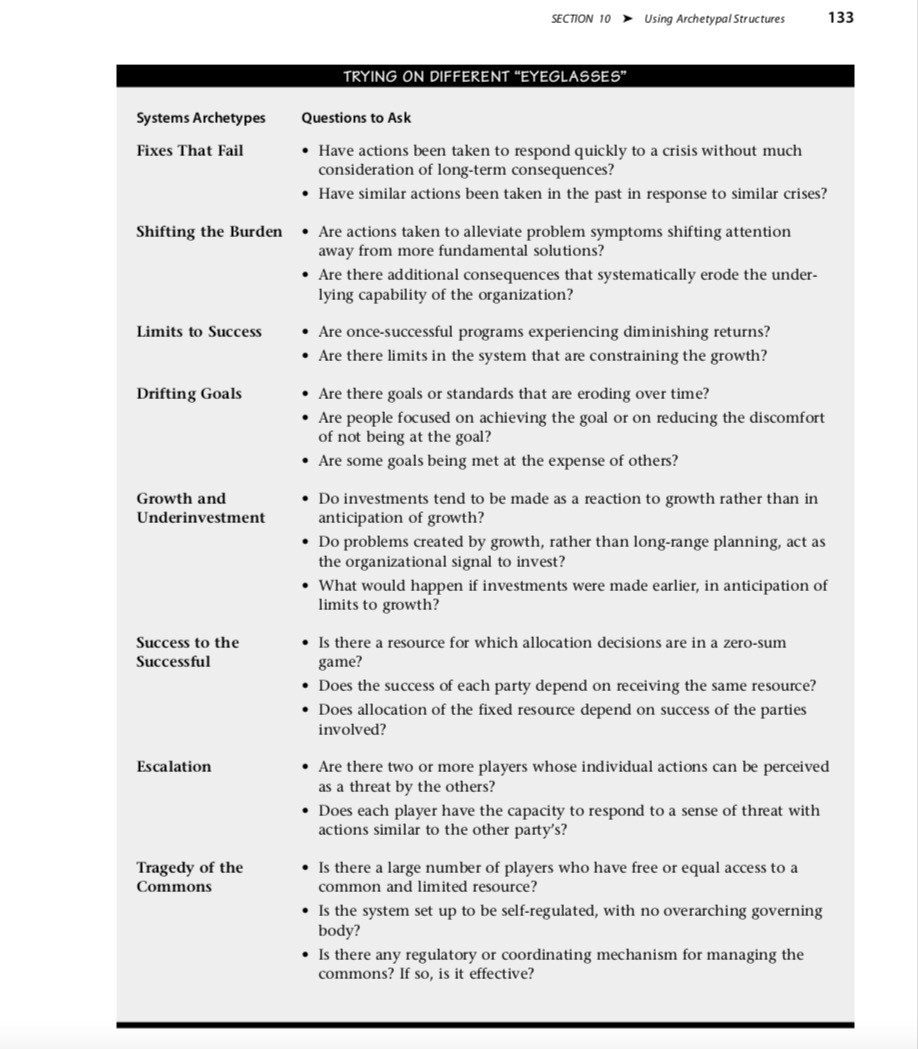
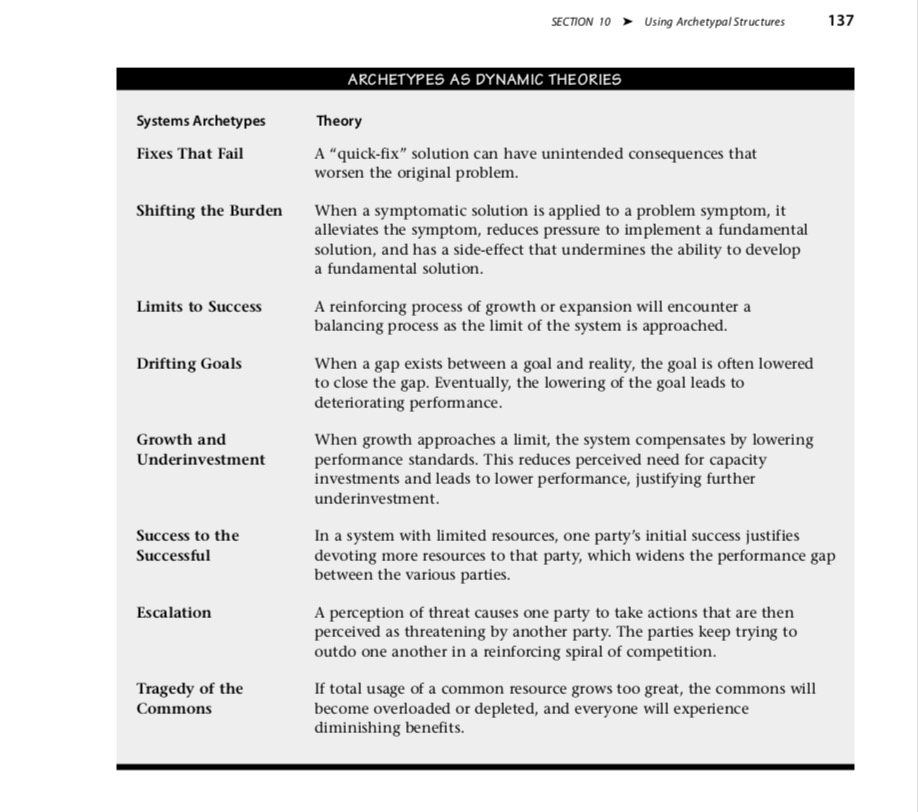



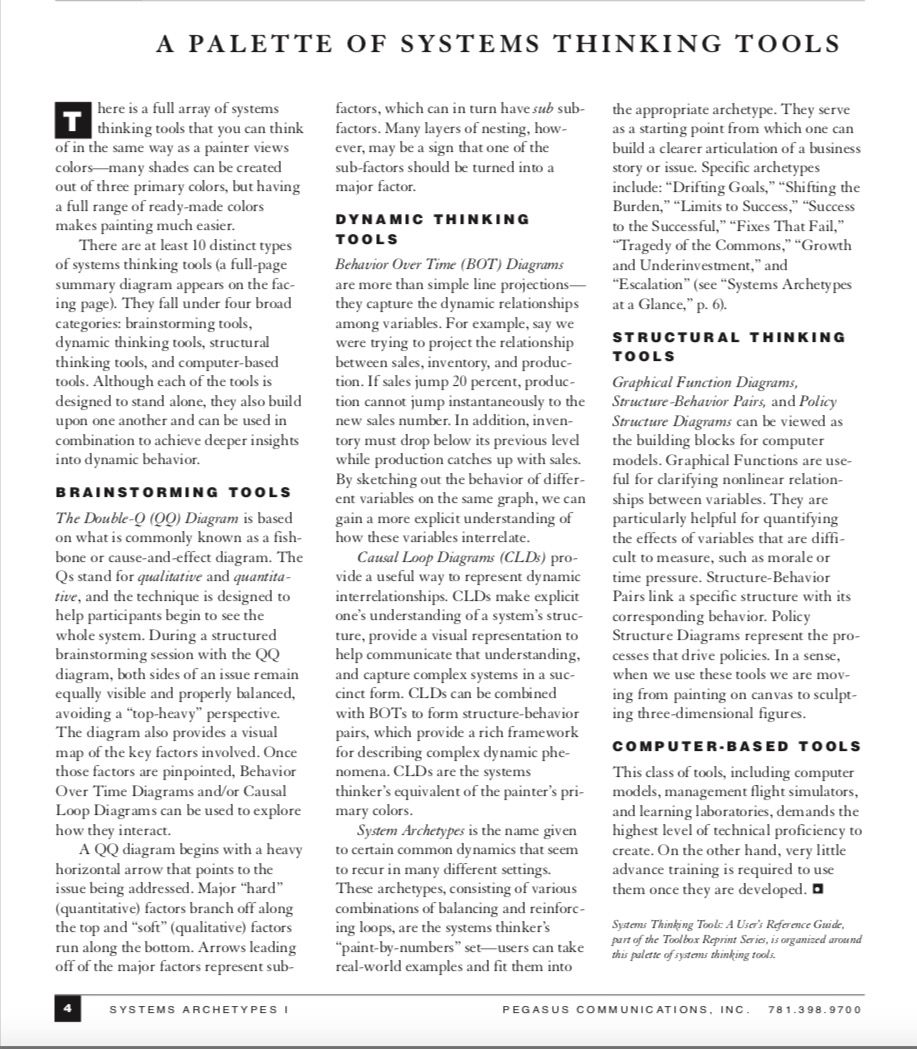


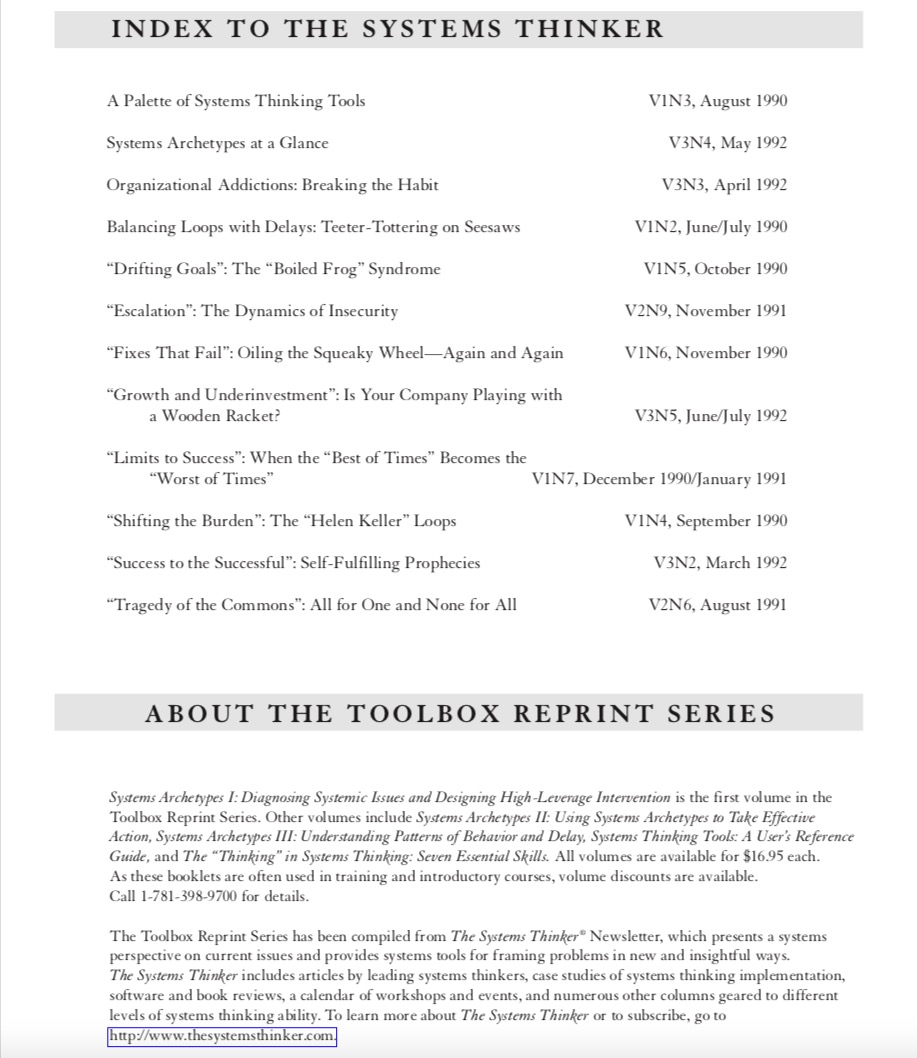

 Karl Dodd1,
Karl Dodd1,